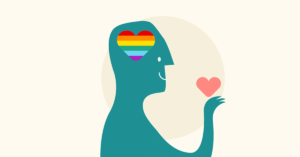As our understanding deepens, it’s clear that the experiences of individuals within specific communities, such as the LGBTQ+ community, can significantly influence their mental health and overall well-being. This blog aims to shed light on the unique mental health challenges faced by the LGBTQ+ community. This will foster understanding and empathy. Also, provide resources and strategies for support and care.
Contents
Understanding the LGBTQ+ Community
 The LGBTQ+ community is a diverse, vibrant group of individuals who identify as lesbian, gay, bisexual, transgender, and/or queer. As well as a range of other non-heteronormative sexual orientations and gender identities. The “+” sign in LGBTQ+ represents additional identities. Such as intersex, asexual, pansexual, and others.
The LGBTQ+ community is a diverse, vibrant group of individuals who identify as lesbian, gay, bisexual, transgender, and/or queer. As well as a range of other non-heteronormative sexual orientations and gender identities. The “+” sign in LGBTQ+ represents additional identities. Such as intersex, asexual, pansexual, and others.
This community is united not only by shared identities but also by common experiences. That even includes the struggle for acceptance and equality, and the unique societal and cultural challenges they face due to their gender identity or sexual orientation. It is important to acknowledge that while there’s a sense of unity in the LGBTQ+ community, there’s also a great deal of diversity.
People within this community come from all races, ethnicities, nationalities, religions, and socioeconomic backgrounds, which further shapes their experiences and identities. Understanding this community requires an appreciation of this diversity and a commitment to inclusivity and respect for all identities.
Connection Between LGBTQ And Mental Health
The LGBTQ+ community is disproportionately impacted by mental health issues due to a variety of factors. These can include:
- stigma
- discrimination
- prejudice
- impact of societal heteronormativity and Cisnormativity
- minority stress
All of which is the chronic stress individuals experience as a result of facing frequent discrimination and bias.
Research consistently shows that individuals who identify as LGBTQ+ are at a higher risk for experiencing mental health problems. For example, it’s estimated that LGBTQ+ individuals are nearly three times more likely than others to experience a mental health condition. They’re also more likely to attempt suicide, particularly during youth.
Unfortunately, these issues can be compounded by a lack of understanding, acceptance, and adequate mental health care resources. That is specifically designed for the unique needs of the LGBTQ+ community. Understanding the connection between LGBTQ and mental health is just one important step toward creating more equitable, supportive environments for all.
Common Mental Health Issues Associated With LGBTQ
 Members of the LGBTQ+ community are faced with unique stressors that can lead to higher rates of certain mental health conditions compared to their heterosexual and cisgender counterparts.
Members of the LGBTQ+ community are faced with unique stressors that can lead to higher rates of certain mental health conditions compared to their heterosexual and cisgender counterparts.
Here are some of the common mental health issues associated with the LGBTQ+ community:
Depression and Anxiety
Depression is a mental health condition characterized by persistent feelings of sadness, hopelessness, and a lack of interest or pleasure in activities. Anxiety disorders are characterized by excessive and persistent worry and fear about everyday situations. Within the LGBTQ+ community, these conditions often arise due to chronic stress from prejudice, discrimination, and stigma related to their identity.
Social rejection or concealment of identity can also contribute to these conditions. Furthermore, the fear of coming out to friends, family, and society can cause increased anxiety.
Suicidal Ideation and Attempts
Suicide ideation refers to thoughts about, or an unusual preoccupation with, suicide. It’s distressingly prevalent among LGBTQ+ individuals, particularly youth and young adults. The Trevor Project’s 2021 National Survey on LGBTQ+ Youth Mental Health found that 42% of LGBTQ+ youth seriously considered attempting suicide in the past year. Also, including more than half of transgender and nonbinary youth.
Many factors contribute to this elevated risk, including discrimination, rejection, bullying, and internalized homophobia or transphobia. Comprehensive support systems, inclusive policies, and affirming mental health services can help reduce these alarming rates.
Substance Use Disorders
Substance use disorders occur when the recurrent use of alcohol and/or drugs causes clinically and functionally significant impairment, such as health problems, disability, and failure to meet responsibilities at work, school, or home. Among the LGBTQ+ community, the prevalence of substance use disorders is often higher due to the unique stressors they face.
Substance use can become a coping mechanism to manage the distress related to stigma, discrimination, and identity struggles. LGBTQ+-affirming treatment approaches can help address these complex issues.
Post-Traumatic Stress Disorder (PTSD)
PTSD is a mental health condition triggered by experiencing or witnessing a terrifying event. Symptoms may include flashbacks, nightmares, severe anxiety, and intrusive thoughts about the event. Many LGBTQ+ individuals experience trauma related to their identity, such as hate crimes, violence, harassment, or severe discrimination.
These traumatic events can lead to PTSD. Moreover, transgender and nonbinary individuals often face higher rates of physical and sexual assault compared to their cisgender peers, contributing to elevated PTSD rates.
Eating Disorders
 Eating disorders are serious conditions related to persistent eating behaviors that negatively impact health, emotions, and the ability to function in important areas of life. These may include conditions like anorexia nervosa, bulimia nervosa, and binge eating disorder. Some research suggests that LGBTQ+ individuals may be at higher risk for developing eating disorders due to a variety of factors, including:
Eating disorders are serious conditions related to persistent eating behaviors that negatively impact health, emotions, and the ability to function in important areas of life. These may include conditions like anorexia nervosa, bulimia nervosa, and binge eating disorder. Some research suggests that LGBTQ+ individuals may be at higher risk for developing eating disorders due to a variety of factors, including:
- societal and internalized pressures to conform to certain body ideals
- discrimination and bullying
- coping mechanisms for dealing with the stress of minority status
For instance, gay men are often overrepresented in eating disorder statistics. Potentially due to societal pressure to maintain a certain body image. Moreover, transgender individuals may use weight control behaviors as a way to suppress characteristics of their assigned sex at birth.
Gender Dysphoria
Gender dysphoria is a psychological condition where a person experiences significant distress or impairment related to a strong desire to be of another gender. That may include a desire to change primary and/or secondary sex characteristics. This condition is unique to transgender and nonbinary individuals. Not all transgender or nonbinary individuals experience gender dysphoria.
However, for those who do, it can contribute to severe distress, anxiety, and depression. Affirmation of one’s gender identity, socially or medically through gender-affirming treatments, can greatly reduce the effects of gender dysphoria.
Remember, mental health is deeply personal and varies greatly from person to person. While these issues are statistically more common within the LGBTQ+ community, it’s crucial not to stereotype or stigmatize them. Not every LGBTQ+ individual will experience these mental health problems. In fact, many lead fulfilling, mentally healthy lives.
Which Gender Has Higher Mental Health?
Research has indicated that the prevalence and types of mental health disorders can vary by gender. But it is critical to remember that mental health issues can affect anyone, regardless of gender. And these statistics do not represent every individual’s experiences.
Studies have shown that women tend to experience higher rates of mood and anxiety disorders. On the other hand, men have higher rates of substance use disorders and are more likely to die by suicide. Despite women having higher rates of suicidal ideation and attempts.
This disparity can be due to a variety of complex factors. Including biological differences, societal expectations, and differences in how men and women are often encouraged to express—or not express—their emotions.
Also, research has shown that transgender individuals are at a higher risk for various mental health conditions compared to their cisgender counterparts, due to factors such as stigma, discrimination, and minority stress. Furthermore, mental health statistics for nonbinary and other gender-diverse individuals are severely lacking, underscoring the need for more inclusive research in this area.
Strategies to Address The LGBTQ And Mental Health Issues
 Addressing mental health issues within the LGBTQ+ community requires a multifaceted approach that includes both individual and systemic changes. Here are several strategies that can help:
Addressing mental health issues within the LGBTQ+ community requires a multifaceted approach that includes both individual and systemic changes. Here are several strategies that can help:
Promote Acceptance and Understanding
One of the key ways to address mental health issues within the LGBTQ+ community is to promote acceptance and understanding within families, schools, workplaces, and communities. Encouraging open dialogue about LGBTQ+ identities can lead to a decrease in stigma and discrimination.
Ensure Access to Affirming Mental Health Care
All healthcare professionals should be trained in LGBTQ+-specific mental health issues, ensuring they can provide sensitive, affirming care. Further, mental health resources need to be accessible and affordable for everyone, irrespective of their sexual orientation or gender identity.
Suicide Prevention Efforts
With suicide rates being high among LGBTQ+ individuals, particularly youth, it’s crucial to have LGBTQ+-specific suicide prevention resources available. Crisis intervention services, such as hotlines and text lines, should be adequately trained to handle the specific concerns of LGBTQ+ individuals.
Support Groups and Safe Spaces
Providing safe spaces, both online and offline, for LGBTQ+ individuals to express themselves freely and support each other can have a positive impact on mental health. Support groups can offer a sense of community and shared understanding that reduces feelings of isolation.
Education and Training
Educate the broader community, including schools, workplaces, and healthcare settings, about LGBTQ+ identities and issues. This can promote acceptance and understanding, reduce discrimination and harassment, and create more inclusive environments.
Advocate for Rights and Legal Protection
Advocate for policies and laws that protect LGBTQ+ individuals from discrimination and hate crimes. Such protections can reduce the minority stress that contributes to mental health issues within this community.
Promote Intersectionality
It’s important to recognize that LGBTQ+ individuals may also belong to other marginalized groups (e.g., racial or ethnic minorities, people with disabilities, etc.). Addressing mental health issues in the community should therefore include a focus on intersectionality and the unique challenges faced by these individuals.
Remember, mental health is deeply personal, and the best strategies may vary from person to person. Each individual deserves care that respects and affirms their identity while providing the help they need.
Conclusion
In conclusion, understanding the LGBTQ and mental health challenges is vital in promoting overall well-being and equality. While it’s true that this community experiences disproportionate rates of mental health issues, largely due to societal stigma, discrimination, and lack of understanding, it’s essential to remember that these challenges do not define the LGBTQ+ community.
Instead, they serve as an urgent call to action for everyone – clinicians, educators, lawmakers, families, and friends – to cultivate a more understanding, accepting, and supportive society.
Life may sometimes be challenging for people from LGBTQ community, but Online LGBTQ Counseling can help. Get experienced LGBTQ therapists at PrideMantra: Book a trial LGBTQ therapy session
![Exploring the Intersection: LGBTQ+ Community and Mental Health]](https://lgbtqiacounseling.com/wp-content/uploads/2023/07/LGTBTQ-Rainbow-small-3.webp)

